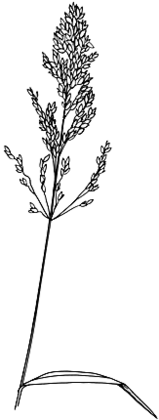Common name: Cultivated Sorghums
Sorghum bicolor (L.) Moench APNI* 
Description: Tufted annuals or weak perennials to >2 m tall
Ligule membranous to 3 mm long, often with hairs to 1 mm long; orifice often with hairs to 1 mm long; blade flat, to 5 cm wide.
Inflorescence open or contracted, to 45 cm long, to 23 cm wide; axils glabrous or with hairs to 1 mm long. Spikelets in pairs, 4–7 mm long, florets 2; lower spikelet sessile, upper spikelet pedicellate, narrower than lower spikelet, terminal spikelets in triplets. Glumes 3–7 mm long, awnless, keeled toward apex, lower 3-toothed, 7–11-nerved, 2-keeled, keels winged forming small lateral teeth at apex; upper 5-nerved. Sterile lemma 2–5 mm long, acute or 2-lobed, 1–2-nerved, sometimes with an awn to 15 mm long; palea absent or reduced. Fertile lemma 4–5.5 mm long, acute or 2-toothed, awnless, 2-nerved; palea absent or reduced.
Flowering: Flowers in summer.
Distribution and occurrence: Cultivated in almost all parts of N.S.W. and hybrids found on disturbed sites in all mainland States.
NSW subdivisions: *NC, *CC, *SC, *NT, *CT, *ST, *NWS, *CWS, *SWS, *NWP, *SWP
Other Australian states: *Qld
| | Key to the subspecies | |
| 1 | Racemes not disarticulating readily at maturity | 2 |
| Racemes disarticulating readily at maturity | 3 |
| 2 | Grains usually exposed at maturity between gaping glumes; axis and branches tough | subsp. bicolor |
| Grain not exposed at maturity; upper portion of the rachis internode attached to the sessile spikelet when the spikelets finally fall.
Back to 1 | subsp. drummondii |
| 3 | Perennial with strong rhizomes. | subsp. almum |
| Weak perennial, without rhizomes. Sessile spikelets break away cleanly from the rachis internodes when falling.
Back to 1 | subsp. arundinaceum |
APNI* Provides a link to the Australian Plant Name Index (hosted by the Australian National Botanic Gardens) for comprehensive bibliographic data
***The AVH map option provides a detailed interactive Australia wide distribution map drawn from collections held by all major Australian herbaria participating in the Australian Virtual Herbarium project.
|


